Beth Kephart's Blog, page 128
June 10, 2013
HANDLING THE TRUTH featured in O Magazine
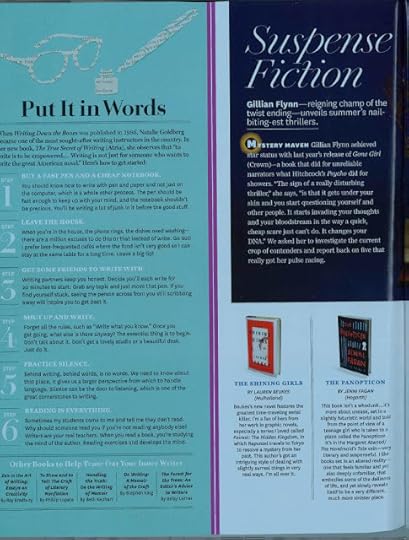
So privileged, so happy. Handling the Truth is featured in the current O Magazine alongside writing books by Natalie Goldberg, Ray Bradbury, Phillip Lopate, Stephen King, and Betsy Lerner.
Huge thanks to Beth Parker of Gotham for sharing Handling with the editors of O.
Those with access to the O Magazine iPad app will find an excerpt of Handling there.




Published on June 10, 2013 09:12
It's Not Love, It's Just Paris/Patricia Engel: Reflections

Anyone who had the privilege of reading Patricia Engel's collection of stories, Vida, knew for sure: a new true writer had emerged, and attention was to be paid. Oh, the sentences, I kept murmuring, as I read. Oh, the heartbreaking sentences. (My thoughts on Vida are here.)
At the BEA two weeks ago, I came home with just three books—Someone by Alice McDermott (the immaculate surprise of that book shared here), Still Writing by Dani Shapiro, and It's Not Love, It's Just Paris by Patricia Engel. Who could need more?
Engel's first novel is the story of an American girl (though indeed, for this is an Engel tale, and Engel is deeply entrenched in many languages and multiple cultures, the heroine is a Colombian American girl) in Paris. Lita del Cielo lives in the "House of Stars" under the care of an aging countess and in the company of other young women with international blood and sure ideas about love. She is a faithful daughter, a skipped-two-grades academic, a girl who wears her one good dress to a safe length below her knees. She is the sort of person who can judge the quality of a friendship by the silence it can withstand, and while the girls in the house go about their notching affairs, Lita waits, ghostwrites term papers for a sustaining fee, helps a young waiter perfect his English. Mostly she watches, and she listens, tries to make sense of the lessons brought to the worn down, still-haughty home of the stars.
Here, for example, Lita is having a conversation with a housemate with whom "you weren't required to respond in order for her to have a full conversation."
"But you see, men are born guilty Women are built to forgive and love and forgive all over again. Men are built for war and because we live in mostly peaceful times, they just turn on themselves. My point is you have to learn to get through life without being sentimental about boys because they are never worth the trouble."
But of course Lita does find a boy—imperfect and mysterious, capable of silence, slow to assume and long to love. He is the son of a notorious politician. His mother is dead and he is ill. He lives by himself near the sea, finds city noise and dust endangering. Lita has only come to Paris for a year. She has come certain that she will return to the family who needs her, but Paris changes everyone and Paris changes Lita.
This is a book filled with incomparable sentences, a book so international in its aura, so mysterious in its trajectory, so veiled and so specific at once. Yearning is a universal language. Paris just after Princess Diana's death, in a house of many languages, through the eyes of an unchastened soul is resolutely particular. I read in awe of Engel's ability to bridge so seamlessly between the two—to burrow so deeply into the story itself and to transcend with great swaths of sudden truth.
My galley is wildly dog-earred. Here, below, one of many additional passages that I loved:
And then I understood that between us there was a common spore of isolation that grew in my overpopulated home and within his quiet cottage. We were young but we'd both grown well into our loneliness. We were the kind of lonely that wasn't ashamed to be so. A lonely without self-penitence.
It's Not Love, It's Just Paris is set to launch on the same day—August 6th—as Handling the Truth , a book birthday we also share with Cool Gray City of Love by Gary Kamiya, whose San Francisco I've observed from the balcony of his home in the hills.
I'm thinking cake. In the meantime, huge congratulations to Patricia Engel, for doing it, again.




Published on June 10, 2013 04:19
June 9, 2013
a Kirkus star for HANDLING THE TRUTH
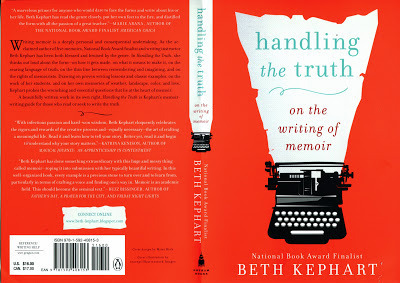
so entirely grateful for this second star from the generous Kirkus reviewer:
A self-described "memoir autodidact" and distinguished author's refreshingly idiosyncratic guide to the art of creative nonfiction.
National Book Award finalist Kephart (Small Damages, 2012, etc.) began her literary career writing "from the margins." This book, which grew out of creative nonfiction classes she taught at the University of Pennsylvania, is not only about "the making of memoir and its consequences," but also "its privileges and pleasures." Though firmly rooted in personal experience, memoir is not an exercise in narcissism. As Kephart shows through examples from writers such as Michael Ondaatje and Annie Dillard, it is a process by which "memoirists open themselves up to self-discovery and make themselves vulnerable." Those interested in writing creative nonfiction must actively read it so that they can begin to know not only what moves them, but what goals to set for themselves in their own work. In setting out to actually write a memoir, Kephart advises writers to start small, using notes on and photographs of everyday life to start, while mining sensory details, situations and landscapes for meaning and metaphor. Awareness of what is at stake, not just for themselves and those whom they portray, but also for their readers, is also crucial. For Kephart, memoir is an act that brings a single person closer to the "us" of collective human experience. In the process of self-discovery—and like the Penn students from whose work she quotes liberally throughout—memoirists must also learn to ask the right questions about the past and about life itself. Perhaps most importantly of all, though, they must remember the things they love. Only then will they find their own authentic way of writing "toward the truth."
Generous, intelligent and genuinely insightful.




Published on June 09, 2013 02:58
June 8, 2013
mucking around (in Good Housekeeping)
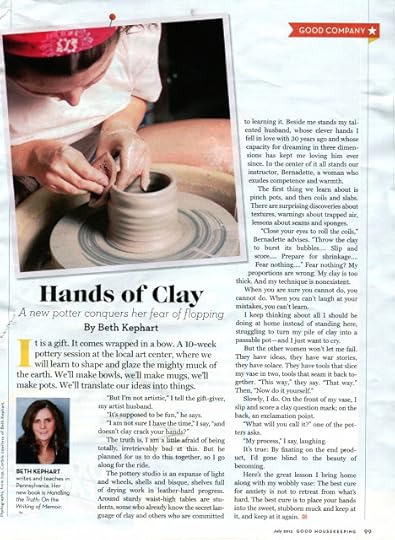
I have Laura Mathews, Amy Rennert, and Fran Lefkowitz to thank for the privilege of this page in the July issue of Good Housekeeping (an issue that has so many good stories in it that I will likely read it front to back).
I have my husband to thank for inviting me to spend a few hours each week doing something new, and for enduring my lack of self confidence. And I have the extraordinary ladies of the pottery studio (as well as my husband) for helping me find ways to see half-conceived or overly ambitious projects through. There is no competition at the Wayne Art Center on Thursday mornings. There are only artists mucking around with clay—centering the pots, pulling the handles, applying the glaze, sharing trade secrets, and loving our saint-ess, Bernadette. It is a particularly peaceful place, and I am grateful for the companionship and for the overt love and generosity that keeps me trying.
Karen Bernstein, thank you for finding the story first, and for letting me know.
And thank you, Good Housekeeping, for being the first magazine to mention Handling the Truth. I guess this means that August 6th, the publication date, is soon.




Published on June 08, 2013 13:09
a scene from the first draft of a long-in-the-making novel

Last week I thought I had finished the novel I'd been working on. But then I read it one more time, and I saw. It was a shaggy 5,000 words too long. It was few shades shy of continuity. It was riding a little high on all the research I had done. And so I spent another several days sitting, thinking, dreaming Florence—shucking off favorite scenes and sentences, because scenes and sentences alone don't make a book.
It's still just a first draft, and it will be just a first draft until Tamra Tuller reads it through. I will return to this novel again. But for now, on this day, I will chill with my son, who has returned home for the day. And then, next weekend, I will go to New Orleans to see one of the students who inspired one of the characters in this novel, to take her out for breakfast. And after that I will live in the not-writing-a-novel space that an exhausted writer must sometimes claim as her own.
A very simple scene from a novel that almost became too complex:
We keep
to the edges of the streets, out of the way of the bikes and the crowds. Little
churches and side streets, scaffold dust, gray pigeons, the Duomo like a
lighthouse, the green stones, the white stones, the dirty stones of Florence. The San Lorenzo market is a river
of wallets, purses, scarves, the cheap Chinese
suitcases that tourists buy to carry their fresh haul home. We force our way
through, my hands in my pockets, my body just bones and blur,
and I risk nothing. The Medici chapel is square and solid, a tomb for a tomb—the
night and day, dusk and dawn of Michelangelo’s Sagrestia Nuova.
There’s
a chip of blue stone in the boy’s ear. There’s a chip of ….
“Nads!”
“What?”
“Keep
up.”
Jack’s place is a bar between postcard shops, racked
souvenirs. It’s a counter with stools, the legs of netted ham hanging from wood
beams, a case of neon gelato. Jack slides up and orders a duo of cream cheese on a
thick crust, two tall cans of coke from a man who knows his name. The walls are
papered with magazine covers and old news, faded maps of Florence.
“Mom takes you here?”
I ask.
“Cream cheese, Nads. Philadelphia
cream cheese.”




Published on June 08, 2013 08:28
June 7, 2013
It's Flourescent! The actual Handling the Truth cover arrives, with blurbs and all
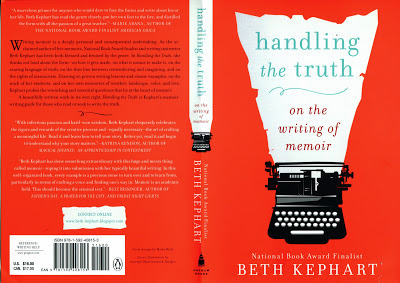
Look what just arrived on this very soggy day.
No one will lose sight of this book.
Ever.
:)
For more on the book, go here.




Published on June 07, 2013 13:54
June 6, 2013
Grateful for this Dr. Radway review in Cleaver Magazine
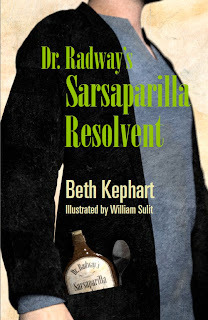
So very grateful to Cleaver Magazine and Michelle Fost for this beautiful review of Dr. Radway's Sarsaparilla Resolvent. It means the world to me that you took notice of a book I loved writing so very much.
I quote the final paragraph here, but please do read the whole. And then take some time to leaf through Cleaver, one of the most exciting new additions to the literary scene in a very long time.
Dr. Radway’s Sarsaparilla Resolvent includes illustrations by
William Sulit, Kephart’s husband, that are a great addition. The novel’s
target audience is young adult (I can imagine it being read in a
classroom) but is enjoyable for older readers also. William buys the
potion of the novel’s title, one of several such colorfully named
elixirs he sees advertised in the Ledger. It’s a sham that might
work its magic for William simply because of the strength of his desire.
He wants, most of all, for it to help his mother. I liked the pile up
of historical artifacts and scenes, I liked the sounds of the names of
things Kephart brought into her story—“the flangers, fitters, riveters,
carters, chippers, caulkers coming in” and so on—that give this story
that begins in a hard scrabble moment in a boy’s life in old Bush Hill a
feeling of abundance.




Published on June 06, 2013 10:59
Handling the Truth Contest: and the winner is
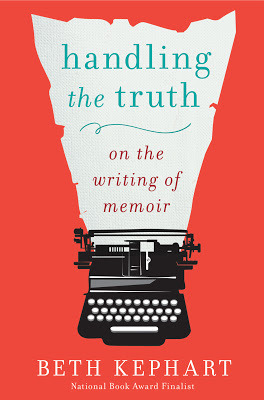
To the nearly two dozen individuals who wrote to share their definition of memoir for the Handling the Truth galley giveaway—my deepest thanks. Your words were remarkable to me, so remarkable that I plan to write about them in a piece that I will share at a later date.
Because your definitions were all equally good, because I know some of you and could not bear to choose among favorites, I randomized the entries and selected the winner blind.
The winner is ..............
Adrienne.
Adrienne, if you could send me, via email, your mailing address, the galley is yours.
Also, announced yesterday, courtesy of the uber-generous Wendy Robards of Caribousmom, was the winner of the Beth Kephart giveaway. For more on that, go here. Thank you, Wendy, and thanks to all of you who participated. It means a lot, and it was very interesting to see which books made their way to the top of your lists.




Published on June 06, 2013 05:06
June 5, 2013
The World Is a Carpet/Anna Badkhen: Reflections

This past Sunday, an entire community gathered in the home of the generous documentary photographer Lori Waselchuk (whom I wrote of here) to celebrate the release of Anna Badkhen's new book, The World Is a Carpet: Four Seasons in an Afghan Village. Cilantro humus, hot peppers, spiced cheese. Artists, intellectuals, neighbors (mostly one in the same). Children and old people like me. Two friends—Lori and Anna—whose friendship ripened in New Orleans in the days following the devastation of Katrina. It was a book party like few others. Lori's entire home was filled. When Anna stood on the stairs to read four pages of her story, Lori's pride in Anna's work was as moving as Anna's astonishing prose.
That kind of pride. That kind of love.
And the children were spellbound.
This is a book (exquisitely packaged with velvetish cover paper on the outside and Anna's own ink drawings within) that evokes an off-the-map village in Afghanistan called Oqa, its door-less homes and sand-roughened people. It's about a place where time doesn't matter but seasons do, where boys marry girls they are not ready for, where imperfection is celebrated as if a carpet's beauty mole. It's about a Russian-American journalist who finds her way not just to this village but into its very soul—into its weddings, its private conversations, its dreams. Over the course of four seasons a carpet will be made—its threads carted home, its weft and warp deliberated, its colors dropped into the dung on the makeshift floor or powdered with the dust of a broken roof. A carpet will be made and carted away, and maybe this very carpet lies now in your living room, and if it does, every knot contains a secret, and it is those secrets, or the intimations of those secrets, that Anna carries forward with her prose.
The book is a fugue—a composition of rare words, future imperfects, irregular verbs, remarkable histories, fragments of Rumi poems, small interludes of the personal I, discrete returns to the making of that carpet. It is tender where tender lives and terrible, too; the deliberate poisoning of a crane, for example, broke my heart, as did the opium doping of babies, and the stagnant arc of lives, and the joyless face of the young bride. Anna's primary companion is a man named Amanullah, whose dreams of being elsewhere are palpable, and sometimes comic, and sometimes not, for not having choices is hardly the thing we want for the people whom we love. The skies are gorgeous, Anna tells us. The sand composes itself into something almost unearthly. Laughter rises up from bare kitchens and from behind the dunes where the townspeople go to relieve themselves. And color. There is color her, in Oqa, and there is color in that rug.
A favorite scene, simply and magically told, concerns a bed brought to Oqa by old Baba Nazar, the only bed in the town. In winter it lives in Baba's room. But look what happens in other seasons:
In warm months the hunter and his son would drag the bed into the sun and anchor its uneven and hollow rusted legs on three clay bricks. Then the bed would become the village centerpiece, teh Oqa equivalent of a town square, or of a mosque. Men would lounge on it as they would on a takht and talk. They would gather around it to listen to newscasts on Baba Nazar's thirty-year-old transistor radio and discuss dispatches from the world beyond their desert, even beyond the serrated Hindu Kush and the Amu Darya. Children would hide under it, run around it in circles, chasing one another, and, when Baba Nazar was not looking and when no adults were sitting on it, bounce on the squeaky springs.
Anna Badkhen writes with transporting authority and poetic license. When she told me that her editor was Rebecca Saletan, I was not surprised. Becky publishes beautiful books.




Published on June 05, 2013 13:36
Summer Reading (and last day for the HANDLING contest)
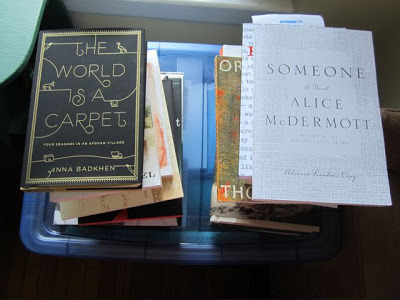
With work on the first draft of my last novel now done, I can, as I mentioned a few days ago, turn to the piles upon piles of books that have been waiting for me. (As well as all the titles I've downloaded on my iPad.)
Recently I have shared my thoughts on Caroline Leavitt's Is This Tomorrow, Katie Haegele's White Elephants, Chloe Aridjis's Asunder, Jessica Keener's Night Swim, Marie Semple's Where'd You Go, Bernadette?, Susan Tekulve's In the Garden of Stone, and Elizabeth Graver's End of the Point.
Throughout the next few months, you'll be hearing from me on books like the following:
Someone, Alice McDermott
The World is a Carpet, Anna Badkhen
It's Not Love, It's Just Paris, Patricia Engel
Still Writing, Dani Shapiro
Country Girl, Edna O'Brien
Reality Boy, A.S. King
The News from Spain, Joan Wickersham
Norwegian by Night, Derek Miller
Grace Before Dying, Lori Waselchuk
River of Dust, Virginia Pye
Perfect Red, Jennie Nash
Behind the Beautiful Forevers, Katherine Boo
Yesterday's Weather, Anne Enright
Some Nerve, Patty Chang Anker
Margot, Jillian Cantor
I'll also be sharing thoughts on a number of classic memoirs.
Speaking of which: Today is your last day to enter to win my last copy of Handling the Truth. The details are here.




Published on June 05, 2013 04:58



